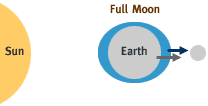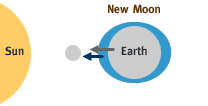Lunar Cycles
Prime horseshoe spawning time is during the evening high tides, at the full moon and the new moon. Their ability to detect the ultraviolet light of the moon (and to sense the cycles of light and dark) enables them to follow the same spawning schedule.
Phases of the Moon
 |
 |
 |
 |
 |
 |
 |
 |
|
New |
Waxing |
First |
Waxing |
Full |
Waning |
Last |
Waning |
The phases of the moon are caused by the relative positions of the Moon and Sun in the sky. For example, the new moon occurs when the Sun and Moon are very close to each other and the full moon occurs when they are in opposite positions.
Lunar Tides
The water on our planet is affected by Earth's gravity (which "holds" it to the planet surface), but it also experiences gravitational attraction from the Moon. This gravitational force drops off as the distance from the Moon increases.
Tides occur because some parts of the Earth are closer to the Moon than others, and those parts experience a stronger gravitational "pull" than parts that are farther away.
  |
In the diagram to the left, you can see that the gravitational attraction of the Moon produces two tidal bulges on opposite sides of the earth. The liquid that is closest to the Moon experiences the greatest gravitational force and is pulled away from the Earth (towards the Moon)-- this creates one bulge.The bulge on the opposite side is created because the Earth is also pulled towards the Moon by gravity. |